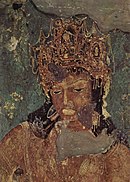Prabhavatigupta
| Prabhavatigupta | |
|---|---|
| Maharani | |
| Regent of the Vakataka Dynasty | |
| Regency | c. 390 – 410 CE |
| Monarch | Divakarasena |
| Queen Consort of the Vakataka Dynasty | |
| Tenure | c. 185 CE - 190 CE |
| Born | Pataliputra, Gupta Empire(Present day Bihar, India) |
| Died | c. 443 Vatsagulma, Vakataka Dynasty(Present day Maharashtra, India) |
| Spouse | Rudrasena II |
| Issue | Divakarasena, Damodarasena and Pravarasena II |
| House | Gupta(By Birth), Vakataka(By Marriage) |
| Father | Chandragupta II |
| Mother | Kuberanaga |
| Religion | Hinduism |
| Vakataka dynasty c. 250 - 510 CE | ||||||||||||||||
|---|---|---|---|---|---|---|---|---|---|---|---|---|---|---|---|---|
| ||||||||||||||||
| Nandivardhana-Pravarapura Branch | ||||||||||||||||
| ||||||||||||||||
| Vatsagulma Branch | ||||||||||||||||
| ||||||||||||||||
Prabhavatigupta (died c. 443[1]) was a Gupta princess and Vakataka queen who was the consort of Maharaja Rudrasena II. Following the death of her husband, she effectively ruled the Vakataka Dynasty as regent from about 390 to 410. She was a devotee of Lord Vishnu.
Early life
[edit]Prabhavatigupta was the daughter of Chandragupta II, the ruler of the Gupta Empire, and queen Kuberanaga. She married Rudrasena II of the Vakataka dynasty during the reign of Rudrasena's father, Prithivishena I.[2] Rudrasena had a short reign of only about five years before he died. Prabhavatigupta had three sons with Rudrasena - Divakarasena, Damodarasena, and Pravarasena – but none of them were adults at the time of their father's untimely death.[3]
Regent of the Vakataka Realm
[edit]Divakarasena, the eldest son of Rudrasena and Prabhavatigupta, was the Yuvaraja or Crown Prince of the Vakataka kingdom. Since he was still a child, Prabhavatigupta assumed the reigns of government and ruled in his name. We know that Prabhavatigupta ruled for at least 13 years as a regent because her Pune grant is dated to the thirteenth year of her own rule, where she calls herself "Mother of the Yuvaraja Divakarasena". It seems that Prabhavatigupta retained control of the Vakataka government even after Crown Prince Divakarasena reached his sixteenth year and was no longer a minor, as there is no evidence that Divakarasena ever ascended his paternal throne as Maharaja. Prabhavatigupta's continued political dominance may be either due to some special circumstances which prevented Divakarasena from ruling in his own name, or simply due to Prabhavatigupta's own love of power.[4]
Divakarasena was eventually succeeded by his younger brother Damodarasena around 410. It is possible that for a time, Prabhavatigupta acted as regent on his behalf as well.[5] During Prabhavatigupta's time in power, Gupta influence over the Vakatakas reached its peak. Prabhavatigupta's inscriptions provide her own Gupta genealogy and emphasize her own natal connections. Her gotra is given as Dharana, which was the gotra of her father, rather than the Vishnuvriddha gotra of the Vakataka dynasty.[6] Indeed, for the 20 or so years of Prabhavatigupta's regency, the Vakataka realm was "practically a part of the Gupta empire."[7]
Later life
[edit]Prabhavatigupta remained active in public life for a few decades after the end of her regency. We find her making a grant in the 19th year of the reign of her son Pravarasena II (c.420–455), where she is called "mother of the illustrious Maharajas Damodarasena and Pravarasena".[4] She was still alive four years later, when Pravarasena II made a grant for the spiritual welfare of both himself and his mother in this life and the next.[8] In the Patna Museum Plate, all religious merit from Pravarasena's donation is said to accrue to the Queen Mother.[9] Prabhavatigupta seems to have concerned herself deeply with religious matters. She is described as a devotee of Bhagavat (Vishnu), and she issued a charter from the feet of her tutelary deity Ramagirisvamin, identified with the deity at Ramtek near Nagpur.[4][10]
References
[edit]- ^ Bakker, Hans (1997). The Vakatakas: An Essay in Hindu Iconology. Groningen: Egbert Forsten. p. 170. ISBN 9069801000.
- ^ Singh, Upinder (2009). A history of ancient and early medieval India : from the Stone Age to the 12th century. New Delhi: Pearson Longman. p. 482. ISBN 978-81-317-1677-9. Retrieved 10 August 2016.
- ^ Shastri, Ajay Mitra (1997). Vakatakas: Sources and History. Aryan Books International. p. 182. ISBN 9788173051234.
- ^ a b c D.C. Sircar (1997). Majumdar, R.C. (ed.). The Classical Age (Fifth ed.). Bharatiya Vidya Bhavan. pp. 180–181.
- ^ Shashtri (1997), p. 183
- ^ Singh (2016), p. 483
- ^ Kulke, Hermann; Rothermund, Dietmar (2004). A History of India (Fourth ed.). Routledge. p. 91. ISBN 9780415329200.
- ^ A.S. Altekar (2007). Majumdar, R.C.; Altekar, A.S. (eds.). The Vakataka-Gupta Age. Motilal Banarsi Dass. p. 104. ISBN 9788120800434.
- ^ Bakker (1997), pp. 23–24
- ^ A.S. Altekar (1960). Yazdani, Ghulam (ed.). The Early History of the Deccan. Oxford University Press. pp. 178–179.


 French
French Deutsch
Deutsch
